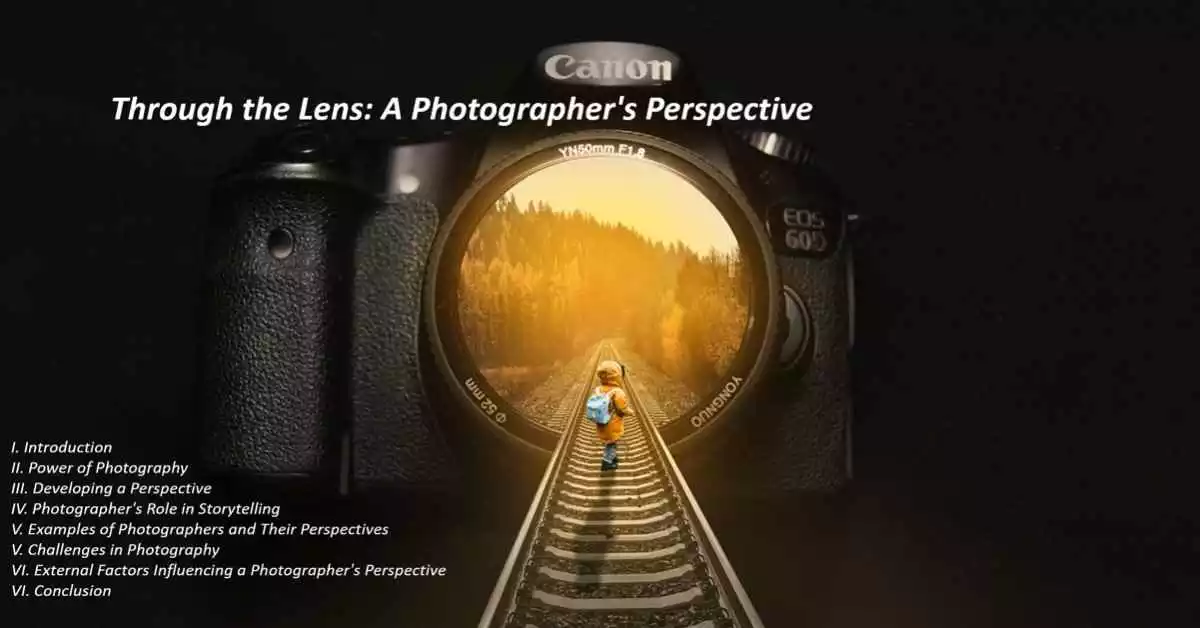Introduction of A Photographer’s Perspective:
The art of photography is more than just capturing an image. It is a form of storytelling that can evoke powerful emotions and convey important messages. In this article, we will explore the importance of a photographer’s perspective in their work.

A Photographer’s Perspective: Image by Hassan Nawaz from Pixabay
A brief overview of the article’s focus on a photographer’s perspective
We will examine how a photographer’s perspective can shape the message of their images, and the impact that photography can have on individuals and society as a whole.
At the heart of this discussion is the concept of perspective – the unique lens through which each photographer views the world. We will explore how a photographer’s perspective is developed through their
experiences and worldview, and the role that self-reflection and awareness play in shaping a photographer’s unique vision.
Through examples of renowned photographers, we will examine how their perspectives have influenced their work, and the power of their images to tell a story and convey a message.
However, photography is not without its challenges. External factors such as client demands and societal pressures can influence a photographer’s perspective and the message of their work.
We will explore these challenges and provide guidance on how photographers can stay true to their perspective and message, while also navigating these external pressures.
Overall, this article aims to provide insight into the importance of a photographer’s perspective in their work and to inspire readers to consider their own unique perspectives in their creative pursuits.
Power of Photography
Photography has a unique ability to capture a moment in time and convey a message or emotion. It has the power to evoke strong feelings and memories and can serve as a powerful tool for communication and storytelling.
One of the most impactful aspects of photography is its ability to influence individuals and society as a whole. Photographs have the power to spark conversations, provoke thought, and bring attention to important issues. They can also serve as historical records, providing insight into different times and cultures. In addition to the power of photography itself, the perspective of the photographer plays a crucial role in shaping the message of their images.
Through their unique lens, photographers can choose what to include or exclude from their frame, and how to present their subject matter. This allows them to convey a particular message or viewpoint through their work.
Overall, the power of photography lies in its ability to capture and communicate a message, and the photographer’s perspective plays a crucial role in shaping that message.
Developing a Perspective
A photographer’s perspective is shaped by their experiences, beliefs, and worldview. It is a unique lens through which they view the world, and it influences the way they capture and present their images.
The development of a photographer’s perspective is an ongoing process, and it can be influenced by a range of factors.
These can include personal experiences, cultural background, education, and exposure to different ideas and perspectives.
Self-awareness and introspection are also important in shaping a photographer’s perspective.
By reflecting on their own biases and assumptions, photographers can develop a deeper understanding of their own worldview and how it influences their work. This can lead to a more nuanced and thoughtful approach to their photography.
Overall, a photographer’s perspective is shaped by a range of factors, including personal experiences, cultural background, and self-awareness. By understanding the influences on their perspective, photographers can develop a unique vision and approach to their work.
Photographer’s Role in Storytelling
Photography is often used as a tool for storytelling, allowing photographers to capture and convey a message or theme through their work.
The photographer’s perspective plays a crucial role in this process, as it shapes the way they approach their subject matter and the message they aim to convey.
Photographers can use a variety of techniques to tell a story through their work. These can include using composition and framing to guide the viewer’s eye, and manipulating lighting and color to create a particular mood or atmosphere.
By choosing what to include or exclude from their frame, photographers can create a narrative that conveys a particular message or theme.
The power of a photographer’s perspective in storytelling is perhaps most evident in documentary photography. Documentarians use their perspective to provide insight into different cultures and experiences, and to bring attention to important issues.
Through their images, they can tell a powerful and impactful story that raises awareness and prompts action. Overall, a photographer’s perspective is essential in their role as a storyteller.
By using their unique lens to approach their subject matter, photographers can tell a powerful story that conveys a particular message or theme.

Examples of Photographers and Their Perspectives
Many photographers use their perspective to convey a particular message or theme through their work. Here are a few examples:
- Dorothea Lange – Lange was a documentary photographer who is best known for her work during the Great Depression. Her perspective was shaped by her own experiences of poverty and displacement, and her images were intended to raise awareness of the struggles of working-class Americans.
- Sebastião Salgado – Salgado is a documentary photographer who has documented the impact of globalization and industrialization on the environment and communities around the world. His images are often stark and powerful, conveying a message of the need for environmental and social justice.
- Cindy Sherman – Sherman is known for her self-portraits, in which she uses her perspective to challenge traditional gender roles and societal expectations. By presenting herself in a variety of roles and personas, she questions the idea of fixed identity and challenges viewers to question their own assumptions.
- Ansel Adams – Adams’ perspective was shaped by his deep appreciation for the natural world, and his images often celebrated the beauty and power of nature. Through his work, he aimed to convey a message of the importance of preserving and protecting the environment.
Overall, these photographers and many others have used their perspective to tell powerful and impactful stories through their work.
Their images convey messages that are often deeply personal, and they have the power to inspire and provoke thought in viewers.
Challenges in Photography
While a photographer’s perspective can be a powerful tool for storytelling, it can also present challenges in maintaining their message and staying true to their vision. Here are a few challenges faced by photographers in this regard:
- Commercial pressures – Photographers who work commercially may face pressures to conform to the expectations of their clients or to create images that are more marketable. This can make it difficult to maintain their perspective and stay true to their message.
- Creative burnout – Photographers who work on long-term projects or who tackle challenging subject matter may experience creative burnout, which can make it difficult to maintain their perspective and continue to produce meaningful work.
- Ethical considerations – Photographers who work in sensitive or controversial subject matter may face ethical considerations in how they present their images. Balancing the need to tell a story with the need to respect the privacy and dignity of their subjects can be a difficult challenge.
- Societal pressures – Photographers may face societal pressures to conform to certain expectations or to produce images that fit within a particular cultural or political context. This can make it difficult to maintain an independent perspective and tell a story that challenges the status quo.
Overall, photographers face a range of challenges in maintaining their perspective and staying true to their message. By being aware of these challenges and actively working to overcome them, photographers can continue to produce meaningful and impactful work.
External Factors Influencing a Photographer’s Perspective
A photographer’s perspective is shaped not only by their personal experiences and worldview but also by external factors that can influence how they see and approach their subject matter.
Here are a few examples of external factors that can impact a photographer’s perspective:
- Cultural context – The cultural context in which a photographer lives and works can have a significant impact on their perspective. Different cultural values, beliefs, and practices can shape how a photographer sees and interprets their subject matter.
- Social and political climate – The social and political climate of a particular time and place can also influence a photographer’s perspective. For example, a photographer working in a time of social unrest or political upheaval may approach their subject matter differently than a photographer working in a more stable environment.
- Technology – Advances in technology can also impact a photographer’s perspective. For example, the development of digital photography has allowed photographers to capture images more easily and quickly, and to experiment with different techniques and styles.
- Accessibility – The accessibility of a particular location or subject matter can also impact a photographer’s perspective. For example, a photographer who has easy access to a particular location may be able to capture images that someone who does not have access cannot.
Overall, external factors can play an important role in shaping a photographer’s perspective. By being aware of these factors and actively working to engage with them, photographers can continue to develop their perspective and produce meaningful and impactful work.
Conclusion
A photographer’s perspective is a powerful tool for storytelling, and it is shaped by a range of personal and external factors. Through their perspective, photographers are able to convey powerful messages and challenge viewers to question their assumptions and beliefs.
However, maintaining a clear perspective and staying true to their message can present challenges, including commercial pressures, creative burnout, ethical considerations, and societal pressures.
Despite these challenges, photographers who are able to maintain their perspective and engage with external factors can continue to produce meaningful and impactful work that resonates with viewers.


